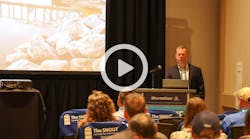
So much of the work on many ESC projects—stream restoration, bank stabilization, or simply preventing further erosion on a site—depends on understanding the behavior of water. The movement of streams and river systems—fluvial geomorphology—is fascinating but, for many of us, dauntingly complex. A two-part webinar from Forester University makes it understandable even for those without an engineering background. “Fluvial Geomorphology (for Those Who Skipped It in College)” is taught by popular speaker David T. Williams.
The first part of the presentation takes place today, Tuesday, June 16, with the second part on Thursday. There is still time to register, or if you can’t fit it into your schedule today you can watch one or both parts as an on-demand webcast. (Click here for a complete list of webcasts.) This webinar is part of the Surface Water Master Class Series, which is also available on demand.
The presentation explores the fundamentals of fluvial geomorphology, examining the evolution, structure, function, intricacies, and dynamics of river systems, and how fluvial geomorphology intersects with other disciplines (e.g., geology, ecology, and engineering). After covering the basics, it delves deeper into watersheds, hillslope and stream hydrology, soil erosion and land degradation, river channel dynamics, sediment transport, flooding and flood management, floodplains, and deltas.
Part 1 explores fluvial geomorphology and its relationship with watersheds, including the common terms and watershed elements, stability and instability definitions and conditions, and causes of river instability. It also discusses watershed hydrological classification, channel profile and shape, and limitation of channel layouts for stream restoration projects.
Part 2 moves beyond river behavior and into the computational tools you can use to determine design features for restoring streams based upon fluvial geomorphologic theories. It covers various channel forms and their important features, as well as explores the Rosgen stream classification system, guidelines, and best practices for use. Finally, it looks at advanced stream restoration projects and their involvementof geomorphology, including channel forming discharge and equilibrium slopes.
See a video here with David Williams talking about some of the points he’ll be covering in the webinar.
For more information and registration, click here.
About the Author
Janice Kaspersen
Janice Kaspersen is the former editor of Erosion Control and Stormwater magazines.

